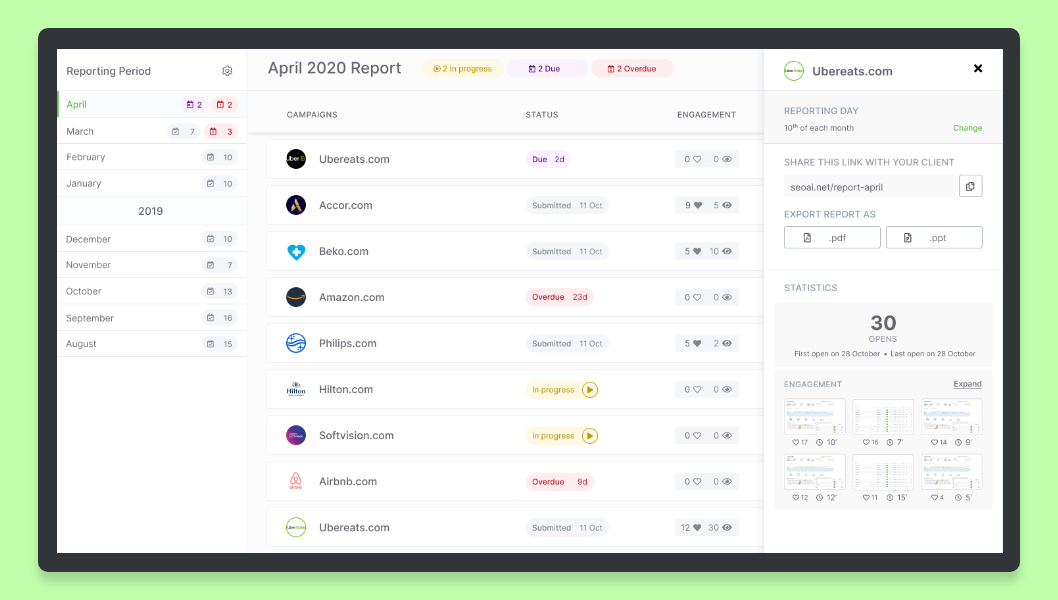Establishing the business value of your SEO performance as an agency is part of client relationship building. It’s also what keeps the churn rate low and the referral rate high.
Yet, when it comes to reporting, why is it that some things get lost in translation?
Picture this – an SEO agency just managed a massive win for their automotive client, a 5% visibility improvement on both desktop and mobile for their highly competitive keywords list in the last month. From the content-driven campaign, over 25 links were built as well for one of the client’s main money pages.
But all of these insights are compiled in a fully automated report that gets sent to the client, together with all the technical tasks and other actions, without being highlighted in particular.
How can the agency make sure the client understands the ROI delivered for their business? Maybe the team is relying on the monthly meeting, but the client postpones that too.
Reporting is a critical activity for an SEO agency – one that supports effective communication and retention. And it can be tedious or strenuous work.
At times, clients don’t react as expected – but doesn’t have to be so.
Let’s dive deeper into reasons why reports sometimes fail to accomplish their objective and what do to about it, to make the best of your reporting process.
Here’s Why Clients Don’t Read Your Reports
Clients Have Different Expectations
One reason why clients won’t read reports can be the implicit expectation to see certain metrics included there or to receive them at a certain date. Or it can be that they don’t understand the specifics of your SEO activities, so they let it slide.
Keeping your clients close from day 0 is mandatory for communications to work. That means setting the right expectations regarding the agency workflows and what’s expected of the client’s team from the onboarding phase.
Reporting is a huge chunk of that so be sure to take into account the following questions and clarify them in the first month:
- Why do we report?
- When do we report?
- How do we go about reporting?
- What data goes in and where do we get that information?
- Who is responsible for this client’s reports?
- When should we escalate an issue? When do we make recommendations?
- What’s the frequency of our reporting and meetings?
After negotiating all those aspects above in the agency-client alignment meeting, you can create an agency internal dashboard that includes your clients’ portfolio, the account managers responsible for each client report, monthly statuses, and due dates. That way you have an overview of your reporting process at all times.
Being able to articulate how your monthly activities and SEO interventions are improving business results will not only be beneficial for your client’s trust, but also for their continued collaboration.
Confusing, Long, or Unbalanced Reports
Whether it’s a fully automated 70 pages report containing every single SEO action the agency’s done or a document with inconsistent branding and copy-pasted data from various tools – it’s not an actionable document that a client can easily read and understand.
You need to have the end goal in mind: the client reading and getting how your work is helping the business. If the client doesn’t engage with your report, it’s a missed opportunity for both showcasing results and gathering feedback.
To avoid these situations, once more think about the main KPIs and SEO objectives you’ve agreed upon:
- Do they have a keyword list they’re particular about?
- Are they an ecommerce client wanting to increase the conversion rate?
- Is it a lead generation campaign?
Having clarified the expectations and business objectives, that’s what you’ll report on monthly while explaining how your SEO intervention directly impacted their KPIs and business results.
To settle inconsistencies, you can create an agency template with a focus on these key insights and your agency’s brand and unique voice:
- Think about highlighting the most important trends and victories on KPIs like non-brand organic traffic and Visibility trends.
- Areas of focus and keyword groups.
- Content performance.
- Competitors’ insights.
- Major updates that affected the campaign (if applicable).
- Technical insights and recommendations.
- SEO opportunities.

Then, you’ll have a good foundation that you can go on personalizing for each client.
After all, as each SEO campaign has its particularities, you need to make sure you report on the client’s specific requests.
Too Much Data, Not Enough Explanations
Apart from long or unbalanced documents, another reason for clients skipping on reading the monthly reports can be data-heavy documents, with lists upon lists of keywords and complex graphics that aren’t self-explanatory for a non-SEO specialist.
Sometimes you might work with in-house SEO professionals, but most of the time it will be a stakeholder that is interested in reaching their business goals, so they need to talk business. And even if you’re the extension of the in-house SEO and digital marketing team, they still need to justify the ROI of collaborating with your agency.
In the end, highlighting how you influenced marketing leads and sales is much more important than going into the nitty-gritty of rankings and traffic.
Want more time to focus on what matters? Then think about ways to automate data gathering.
Instead of spending multiple hours in your SEO tools, copying charts, making screenshots, and searching for the most relevant insights, optimize for time and integrate these actions into your daily routines.
For instance, with a reporting module like SEOmonitor’s, you get an assistant in the form of a Google Slides add-on that surfaces the critical insights from your campaign – that you can insert with a click. Those insights are transformed into visually appealing slides, within your predesignated agency template.
You get to focus on what matters – explaining the metrics behind your actions, how the strategy evolved, and what’s next for the client’s business.
Inconsistent Reporting Frequency
Was it supposed to be monthly? Or did you agree on a custom period?
Not getting the timing right and in alignment with your client can be another reason why reports pile up in the unread file.
Having a set frequency, which is usually month by month, helps both from a process point of view and as a ground for calibration with the client’s team.
To make sure you send your reports on time, you can use a project management tool or, again, your internal agency dashboard. Having a support system with nudges and alerts, via email, Slack or something else, keeps you on schedule.
Don’t forget to set your notifications beforehand for preparation – compounding the insights and creating the document itself. Also, you may think about the roles involved in the reporting process from the start, so you coordinate with all the team members in due time.
Unmet Expectations
There may be unmet expectations on both sides: your team made some important SEO recommendations that the client hasn’t implemented, the client expected to see a different outcome.
Returning full circle to the crucial part of alignment and expectations setting, there’s also one final aspect to take into account: communicating why it’s important to receive the report beforehand and read it.
It can work as agenda-setting for the last step in the reporting process – presenting it.
It’s also in the monthly meeting or call that you get to clarify, explain, and make recommendations while presenting the journey so far.
It can even be an opportunity to recalibrate the relationship with a silent client. It’s not the unread report per se that needs solving, but the way you both communicate.
Maybe it’s time to rehash what you both agreed during onboarding or maybe it’s time for a new approach that benefits both sides.
All in all, having the same foundation for this discussion raises its efficiency. You and the client can now focus on campaign fine-tuning and strategic talk because you know where you’re standing, the questions that need urgent answers, and can infer the next steps.
Ways to Optimize Your Reporting Process
Creating an efficient reporting process for your agency is important because, to a certain degree, reporting is retention.
Being able to articulate how your monthly activities and SEO interventions are improving business results will not only be beneficial for your client’s trust, but also for their continued collaboration.
In brief, here are the main things to consider when designing that reporting process:
- Establishing the rules of reporting and clearly communicating them to the client in the onboarding phase.
- Having a set internal process for how you approach reporting and its strategic objective.
- Create a visually appealing monthly report to use across the agency, that showcases your approach and the most relevant SEO insights: SEO actions, visibility status, keyword groups, and their performance, competitors insights, SEO issues and opportunities, and next steps.
- Automating data gathering so you have time to focus on what matters: strategy, tactics, and explaining what happened in order to translate SEO interventions to business results.
- Creating a transparent process and gathering feedback. Your reports and meetings are a great opportunity to take the pulse of your clients and find out what you can optimize. For the sake of transparency, you should offer your clients the context to give you feedback and ask burning questions.
Our team at SEOmonitor researched this process through and through, and after gathering insights from SEO agencies, designed a reporting module that takes into account all the aspects above, so you don’t have to struggle.
You get:
- An overview of your reports’ status at the portfolio level.
- The status of a client’s report at each stage of the process (Due, Overdue, Submitted, In Progress), in your account manager dashboard.
- A builder that leverages your campaign data from SEOmonitor into Google Slides – our smart assistant pulls the most relevant insights from each campaign that you can click and insert in your agency template in seconds. Plus, we’ll generate visually consistent graphs and charts that are easy to follow.
- A feedback tracker for each monthly report that highlights engagement data: the most engaged slides, the most liked slides, and the client’s overall satisfaction, collected at the best possible moment – just after reading your report.
Reporting doesn’t have to be a painful or time-consuming experience for your team. And it can be significant for supporting client communications.
Join us, and hundreds of SEO agencies’ clients, in the journey of bringing more transparency and measurability to the SEO industry.
Discover a reporting solution
designed just for SEO agencies.
The opinions expressed in this article are the sponsor's own.





